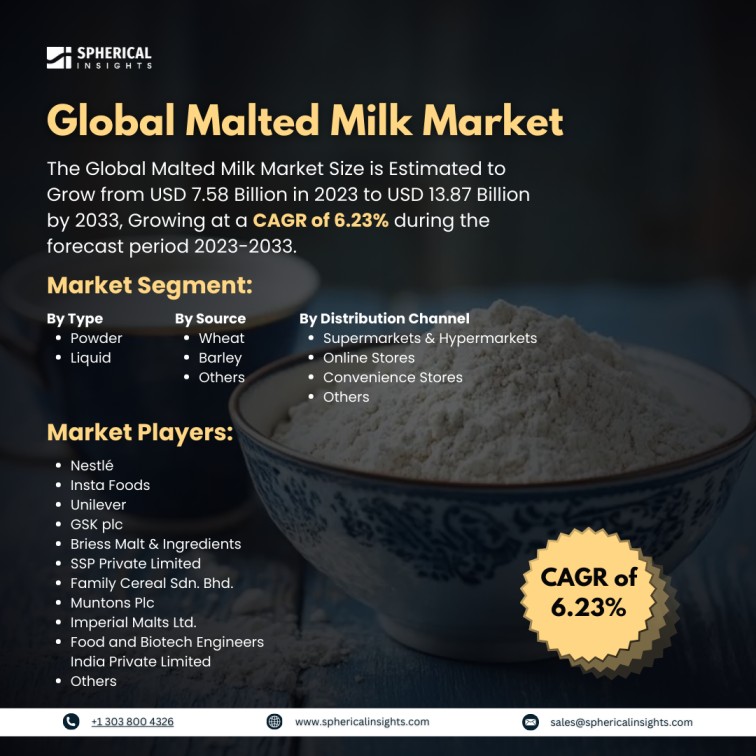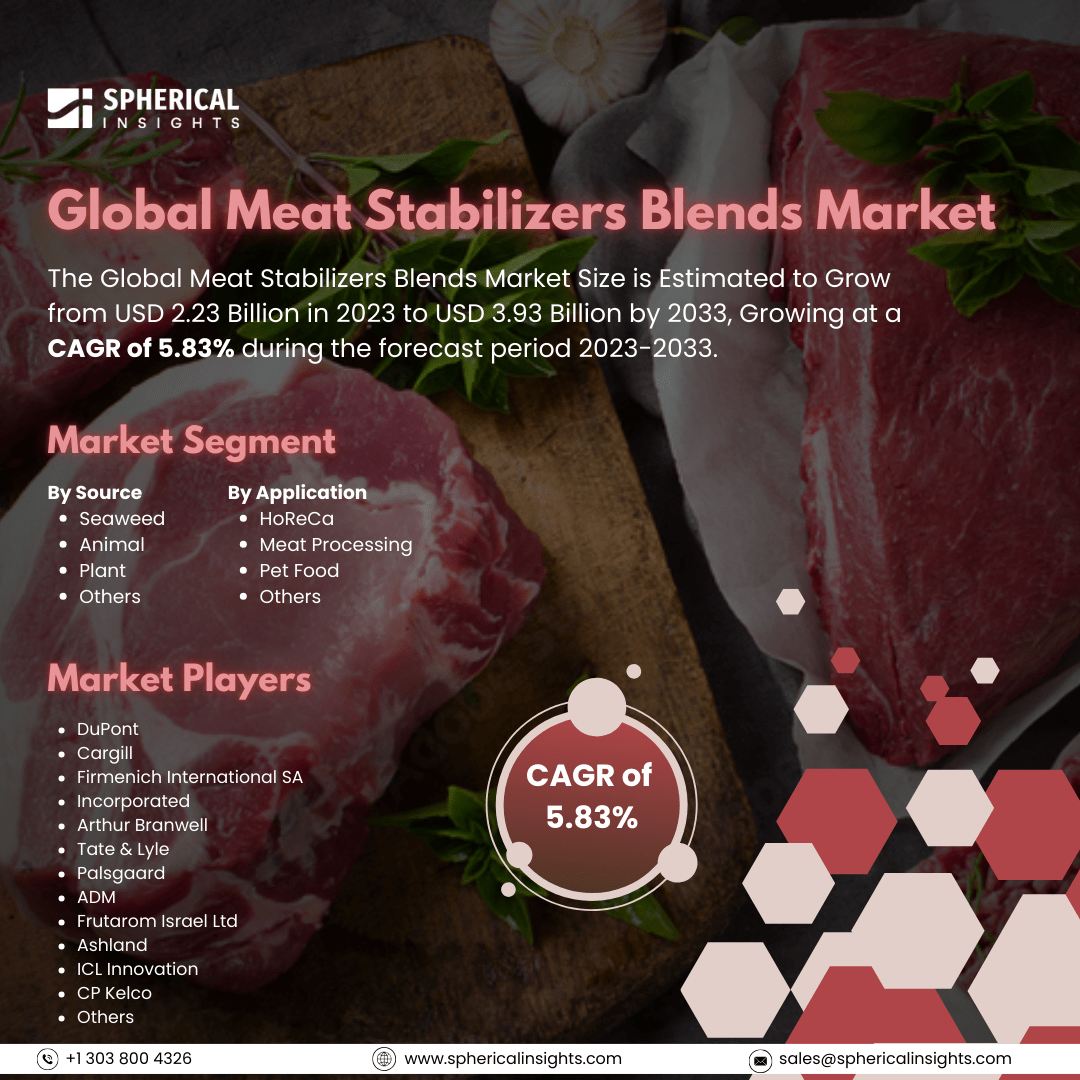Global Malted Milk Market Size to Worth USD 13.87 Billion by 2033
According to a research report published by Spherical Insights & Consulting, the Global Malted Milk Market Size is Estimated to Grow from USD 7.58 Billion in 2023 to USD 13.87 Billion by 2033, Growing at a CAGR of 6.23% during the forecast period 2023-2033.
Browse key industry insights spread across 215 pages with 110 Market data tables and figures & charts from the report on the Global Malted Milk Market Size, Share, and COVID-19 Impact Analysis, By Type (Powder and Liquid), By Source (Wheat, Barley, and Others), By Distribution Channel (Supermarkets & Hypermarkets, Online Stores, Convenience Stores, and Others), and By Region (North America, Europe, Asia-Pacific, Latin America, Middle East, and Africa), Analysis and Forecast 2023 – 2033.
The market for goods derived from a combination of milk and malted barley and wheat flour is known as the globally malted milk market. Malted milk provides vital nutrients including vitamins, minerals, and proteins, which is one of the primary drivers of the growing customer preference for wholesome and health-conscious beverages. Additionally, there is a growing demand for ready-to-drink and handy products due to shifting lifestyles and rising disposable incomes. The market is expanding as a result of malted milk's rising appeal as a component in a variety of dishes and desserts. In addition, manufacturers' creative product lines and marketing approaches are drawing in a wider range of customers, which is improving market expansion prospects during the duration of the forecast year. Product sales are being driven by manufacturers' emphasis on employing natural ingredients. High product use as a nutritional supplement and growing knowledge of the many advantages of malted foods and beverages will support market expansion even more. Changes in dietary choices, such as the increased need for little snacks brought on by busy lives, fast urbanization, and industrialization, will also have a favorable effect on market expansion. Demand is also anticipated to rise as a result of advancements in bite-sized foods, such as baked goods such as cookies made with malted milk powder. However, the rising cost of raw materials is one of the main issues facing the global malted milk market.
The liquid segment held the largest share of 70.14% in 2023 and is estimated to grow at a CAGR of 4.78% throughout the projection period.
Based on the type, the global malted milk market is categorized into powder and liquid. Among these, the liquid segment held the largest share of 70.14% in 2023 and is estimated to grow at a CAGR of 4.78% throughout the projection period. It is nutrient-dense and contains vitamins A, D, E, and K. While all liquids including water, milk, juice, oil, tomato sauce, honey, and custard are considered special liquids, non-newtonian solutions are not. The heart-healthy combination of fiber, potassium, folate, and vitamin B6 found in malt promotes inferior fatty acids and lowers the risk of heart disease. By increasing cholesterol obsession from the stomach, its dietary fiber promotes cholesterol collapse and reduces insulin movement.
The wheat segment accounted for the largest share of 65.51% in 2023 and is anticipated to grow at a significant CAGR during the forecast period.
Based on the source, the global malted milk market is classified into wheat, barley, and others. Among these, the wheat segment accounted for the largest share of 65.51% in 2023 and is anticipated to grow at a significant CAGR during the forecast period. Customers perceive wheat to be an easy source to obtain because it is less expensive and provides a superior foundation for high-quality ingredients. Soaked and germinated malt makes up the majority of the mixture. A variety of grains have been used, including corn, rice, and wheat. Hefeweizen and other outdated wheat varieties frequently use wheat malt because it has a unique, recognizable flavor similar to wheat flour. Although it contains a little more protein than White Wheat Malt, it still flows easily through the brewhouse.
The supermarkets & hypermarkets segment dominated the global malted milk market share in 2023 and is estimated to grow at a CAGR of 5.19% throughout the projection period.
Based on the distribution channel, the global malted milk market is divided into supermarkets & hypermarkets, online stores, convenience stores, and others. Among these, the supermarkets & hypermarkets segment dominated the global malted milk market share in 2023 and is estimated to grow at a CAGR of 5.19% throughout the projection period. This is because supermarkets & hypermarkets can exhibit a wide variety of products at the same time and location, making it easier for customers to make purchases. Additionally, supermarkets & hypermarkets can offer discount coupons to customers who purchase in greater quantities than usual, which benefits both parties.
Asia Pacific is expected to hold the largest share of the global malted milk market through the forecast period.
Asia Pacific is expected to hold the largest share of the global malted milk market through the forecast period. The region's expanding population and rising disposable incomes, which have increased demand for wholesome and practical food and beverage items, are major factors contributing to this dominance. In nations such as India, where malted milk drinks are widely enjoyed as both delicious treats and healthful beverages, their cultural importance is also very important. Malted milk's appeal in the area has also been boosted by the growing retail infrastructure and the growing impact of Western eating practices. The Asia Pacific area now holds a dominant position in the global malted milk market because of creative product offers and intensive marketing campaigns by both domestic and foreign firms.
Europe is predicted to grow at the fastest CAGR of the global malted milk market over the forecast period. European consumers' growing health consciousness is driving up demand for nutrient-dense drinks, with malted milk being viewed as a rich source of vital nutrients. There is a particularly significant tendency in this area toward fortified and functional foods. The commercial reach of malted milk is also being expanded by its increasing appeal as a component in a variety of culinary applications, such as baking and confections. Additional consumers are choosing malted milk products as a result of established retail networks and the growing popularity of natural and organic products. As producers keep coming up with novel tastes and formulas, the European malted milk market is anticipated to expand rapidly.
Competitive Analysis
Major key players in the global malted milk market include Nestlé, Insta Foods, Unilever, GSK plc, Briess Malt & Ingredients, SSP Private Limited, Family Cereal Sdn. Bhd., Muntons Plc, Imperial Malts Ltd., Food and Biotech Engineers India Private Limited, and others.
Recent Developments
- In July 2024, the Canadian agribusiness Richardson International Limited paid an unknown sum to acquire Ragleth Ltd. Richardson aimed to increase its growth and diversify its operations in the food production industry with this acquisition. The acquisition enabled Anglia Maltings to achieve its objective of acquiring new ingredients and exploring new business prospects. Malted milk products were produced by Ragleth Ltd., a company situated in the United Kingdom.
Key Target Audience
- Market Players
- Investors
- End-users
- Government Authorities
- Consulting and Research Firm
- Venture capitalists
- Value-Added Resellers (VARs)
Market Segment
This study forecasts revenue at global, regional, and country levels from 2023 to 2033. Spherical Insights has segmented the global malted milk market based on the below-mentioned segments:
Global Malted Milk Market, By Type
Global Malted Milk Market, By Source
Global Malted Milk Market, By Distribution Channel
- Supermarkets & Hypermarkets
- Online Stores
- Convenience Stores
- Others
Global Malted Milk Market, By Regional
- North America
- Europe
- Germany
- UK
- France
- Italy
- Spain
- Russia
- Rest of Europe
- Asia Pacific
- China
- Japan
- India
- South Korea
- Australia
- Rest of Asia Pacific
- South America
- Brazil
- Argentina
- Rest of South America
- Middle East & Africa
- UAE
- Saudi Arabia
- Qatar
- South Africa
- Rest of the Middle East & Africa



